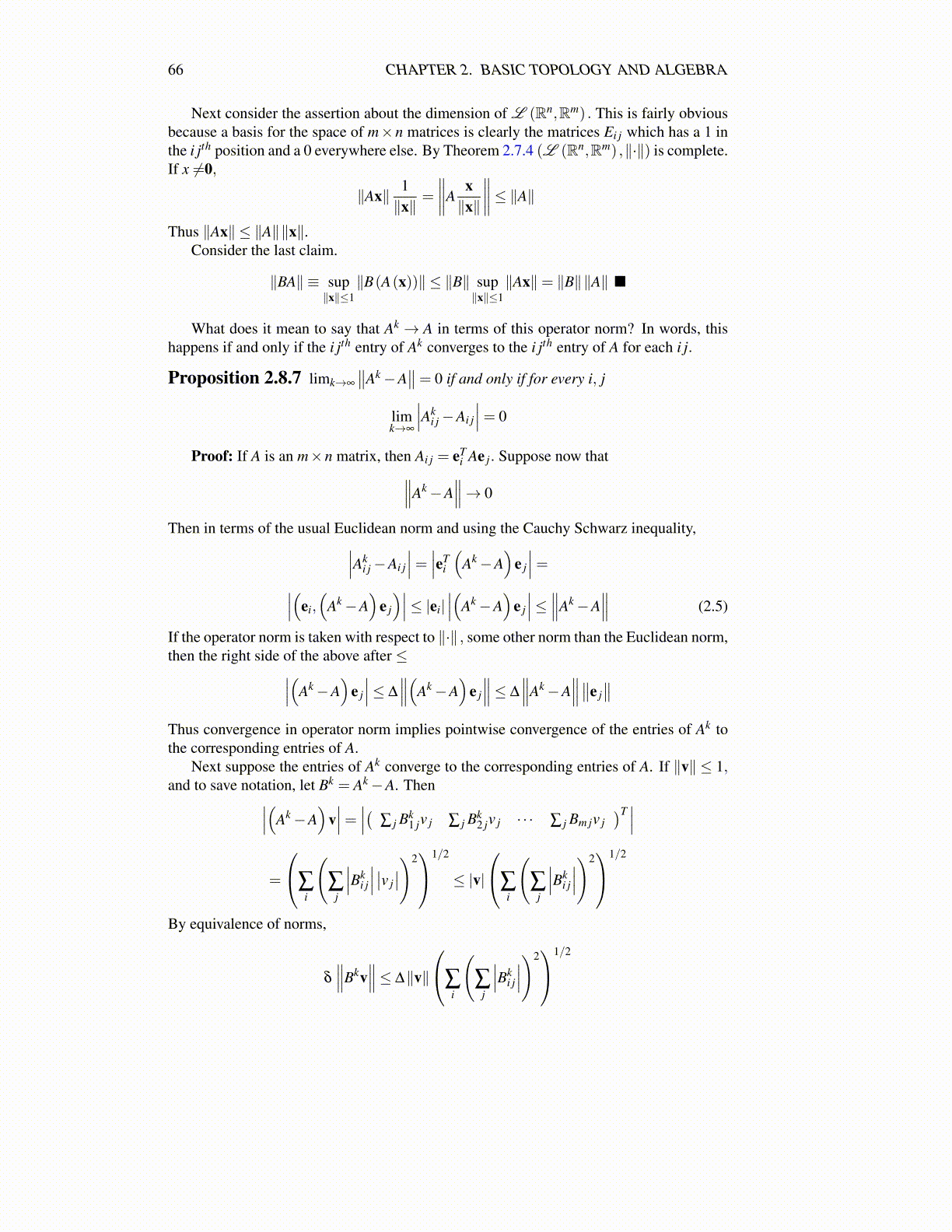
66 CHAPTER 2. BASIC TOPOLOGY AND ALGEBRA
Next consider the assertion about the dimension of L (Rn,Rm) . This is fairly obviousbecause a basis for the space of m×n matrices is clearly the matrices Ei j which has a 1 inthe i jth position and a 0 everywhere else. By Theorem 2.7.4 (L (Rn,Rm) ,∥·∥) is complete.If x ̸=0,
∥Ax∥ 1∥x∥
=
∥∥∥∥Ax∥x∥
∥∥∥∥≤ ∥A∥Thus ∥Ax∥ ≤ ∥A∥∥x∥.
Consider the last claim.
∥BA∥ ≡ sup∥x∥≤1
∥B(A(x))∥ ≤ ∥B∥ sup∥x∥≤1
∥Ax∥= ∥B∥∥A∥ ■
What does it mean to say that Ak → A in terms of this operator norm? In words, thishappens if and only if the i jth entry of Ak converges to the i jth entry of A for each i j.
Proposition 2.8.7 limk→∞
∥∥Ak−A∥∥= 0 if and only if for every i, j
limk→∞
∣∣∣Aki j−Ai j
∣∣∣= 0
Proof: If A is an m×n matrix, then Ai j = eTi Ae j. Suppose now that∥∥∥Ak−A∥∥∥→ 0
Then in terms of the usual Euclidean norm and using the Cauchy Schwarz inequality,∣∣∣Aki j−Ai j
∣∣∣= ∣∣∣eTi
(Ak−A
)e j
∣∣∣=∣∣∣(ei,(
Ak−A)
e j
)∣∣∣≤ |ei|∣∣∣(Ak−A
)e j
∣∣∣≤ ∥∥∥Ak−A∥∥∥ (2.5)
If the operator norm is taken with respect to ∥·∥ , some other norm than the Euclidean norm,then the right side of the above after ≤∣∣∣(Ak−A
)e j
∣∣∣≤ ∆
∥∥∥(Ak−A)
e j
∥∥∥≤ ∆
∥∥∥Ak−A∥∥∥∥∥e j
∥∥Thus convergence in operator norm implies pointwise convergence of the entries of Ak tothe corresponding entries of A.
Next suppose the entries of Ak converge to the corresponding entries of A. If ∥v∥ ≤ 1,and to save notation, let Bk = Ak−A. Then∣∣∣(Ak−A
)v∣∣∣= ∣∣∣( ∑ j Bk
1 jv j ∑ j Bk2 jv j · · · ∑ j Bm jv j
)T∣∣∣
=
∑i
(∑
j
∣∣∣Bki j
∣∣∣ ∣∣v j∣∣)21/2
≤ |v|
∑i
(∑
j
∣∣∣Bki j
∣∣∣)21/2
By equivalence of norms,
δ
∥∥∥Bkv∥∥∥≤ ∆∥v∥
∑i
(∑
j
∣∣∣Bki j
∣∣∣)21/2